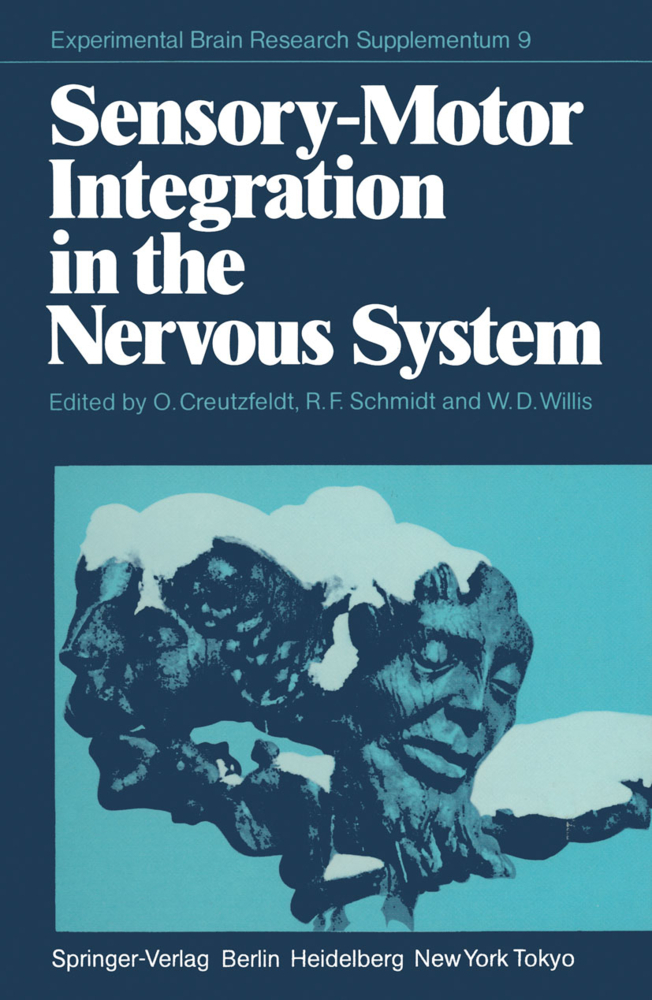Sensory-Motor Integration in the Nervous System
Sensory-Motor Integration in the Nervous System
Over 200 neuroscientists met at the Max-Planck-Institut fur Biophysikalische Chemie in Gottingen between April 7th-9th 1983 in order to honour a foreign member of the Institute, namely Sir John Carew Eccles, who celebrated his 80th birthday on January 27th 1983. It was a lively scientific gathering of former students, colleagues and friends of Sir John and Lady Helena. We had all come together from different parts of the world to celebrate this occasion, which gave us the wonderful chance to meet the various members of a large family, united by respect and gratitude for Sir John. The lectures were based on the many themes which have been at the centre of John Eccles' scientific zeal throughout his life. Indeed the chapter headings of this book have been taken from the book titles of Sir John's own work. We would also have liked to publish the discussions which took place after every lecture and to each of which John Eccles contributed in his usual lively manner, but editing them would not have conveyed the stimulating atmosphere, which Sir John created.
Critical Remarks on the Knowledge of Lower and Higher Organisms, the So-Called Sensory Motor Systems
Impasses and Fallacies of the Brain-Mind Discussion
II. Reflex Activity of the Spinal Cord
Non-invasive Analysis of the Spinal Cord Generators Activated by Somatosensory Input in Man: Near Field and Far Field Potentials
Organization of Reflexes Evoked by Stimulation of Neck Receptors
On Neuronal Pathways of Presynaptic Depolarization of Group I Muscle Afferents
Spinal Integration of the Command for Respiratory Movements
Segmental Control of Pain
Central Effects by Ventral Root Nociceptive Afferents
III. The Cerebellum as a Neuronal Machine
Purkinje Cells of the Cerebellum: Localization and Function of Multiple Neuroactive Substances
Integration of Mossy Fiber and Climbing Fiber Inputs to Purkinje Cells
Cerebrocerebellar Interactions in Premovement Organization of Conditioned Hand Movements in the Monkey
Cerebellar Plasticity and Motor Learning
The Cerebellum and Adaptive Tuning of Movements
Recent Aspects of the Function of the Inferior Olive
IV. The Physiology of Nerve Cells
What Central Inhibitory Pathways Tell Us About Mechanisms of Transmitter Release
Reorganization of Neuronal Membrane Properties Following Axotomy
Posttetanic Potentiation, Presynaptic Inhibition, and the Modulation of the Free Ca2+ Level in the Presynaptic Terminals
Mechanosensibility of Joint Receptors with Fine Afferent Fibers
V. The Physiology of Synapses
The Form and Function of Synapses
Norepinephrine and Acetylcholine Block a Calcium-Activated Potassium Hyperpolarization in Hippocampal Pyramidal Cells
Evidence for Both Pre- and Postsynaptic Mechanisms During Long-Term Potentiation in Hippocampal Slices
Long-Term Potentiation and Inhibition in CA3 Neurons
Synaptic Plasticity in the Red Nucleus
VI. The Understanding of the Brain
Neocortical Neuron Circuit Models Reconsidered in the Light of the New Techniques
The Sensorimotor Integration in Area 3a of the Cat
Neuronal Organization of Cat Motor Cortex
The Supplementary Motor Area in the Light of Recent Investigations
Sensorimotor Integration in an Insect's Brain: The Neurophysiological Basis for the Flashing Dialog in the Firefly Luciola lusitanica (Charp.)
VII. The Neurophysiological Basis of Mind
Anomalous Contours: A Tool in Studying the Neurophysiology of Vision
Attention, Readiness for Action, and the Stages of Voluntary Decision - Some Electrophysiological Correlates in Man
Electrophysiological Cues of the Language-Dominant Hemisphere in Man: Slow Brain Potentials During Language Processing and Writing.
Curriculum Vitae and Bibliography of Sir John Eccles
I. The Self and Its BrainCritical Remarks on the Knowledge of Lower and Higher Organisms, the So-Called Sensory Motor Systems
Impasses and Fallacies of the Brain-Mind Discussion
II. Reflex Activity of the Spinal Cord
Non-invasive Analysis of the Spinal Cord Generators Activated by Somatosensory Input in Man: Near Field and Far Field Potentials
Organization of Reflexes Evoked by Stimulation of Neck Receptors
On Neuronal Pathways of Presynaptic Depolarization of Group I Muscle Afferents
Spinal Integration of the Command for Respiratory Movements
Segmental Control of Pain
Central Effects by Ventral Root Nociceptive Afferents
III. The Cerebellum as a Neuronal Machine
Purkinje Cells of the Cerebellum: Localization and Function of Multiple Neuroactive Substances
Integration of Mossy Fiber and Climbing Fiber Inputs to Purkinje Cells
Cerebrocerebellar Interactions in Premovement Organization of Conditioned Hand Movements in the Monkey
Cerebellar Plasticity and Motor Learning
The Cerebellum and Adaptive Tuning of Movements
Recent Aspects of the Function of the Inferior Olive
IV. The Physiology of Nerve Cells
What Central Inhibitory Pathways Tell Us About Mechanisms of Transmitter Release
Reorganization of Neuronal Membrane Properties Following Axotomy
Posttetanic Potentiation, Presynaptic Inhibition, and the Modulation of the Free Ca2+ Level in the Presynaptic Terminals
Mechanosensibility of Joint Receptors with Fine Afferent Fibers
V. The Physiology of Synapses
The Form and Function of Synapses
Norepinephrine and Acetylcholine Block a Calcium-Activated Potassium Hyperpolarization in Hippocampal Pyramidal Cells
Evidence for Both Pre- and Postsynaptic Mechanisms During Long-Term Potentiation in Hippocampal Slices
Long-Term Potentiation and Inhibition in CA3 Neurons
Synaptic Plasticity in the Red Nucleus
VI. The Understanding of the Brain
Neocortical Neuron Circuit Models Reconsidered in the Light of the New Techniques
The Sensorimotor Integration in Area 3a of the Cat
Neuronal Organization of Cat Motor Cortex
The Supplementary Motor Area in the Light of Recent Investigations
Sensorimotor Integration in an Insect's Brain: The Neurophysiological Basis for the Flashing Dialog in the Firefly Luciola lusitanica (Charp.)
VII. The Neurophysiological Basis of Mind
Anomalous Contours: A Tool in Studying the Neurophysiology of Vision
Attention, Readiness for Action, and the Stages of Voluntary Decision - Some Electrophysiological Correlates in Man
Electrophysiological Cues of the Language-Dominant Hemisphere in Man: Slow Brain Potentials During Language Processing and Writing.
| ISBN | 978-3-642-69933-7 |
|---|---|
| Artikelnummer | 9783642699337 |
| Medientyp | Buch |
| Copyrightjahr | 2011 |
| Verlag | Springer, Berlin |
| Umfang | XVI, 466 Seiten |
| Abbildungen | XVI, 466 p. |
| Sprache | Englisch |







